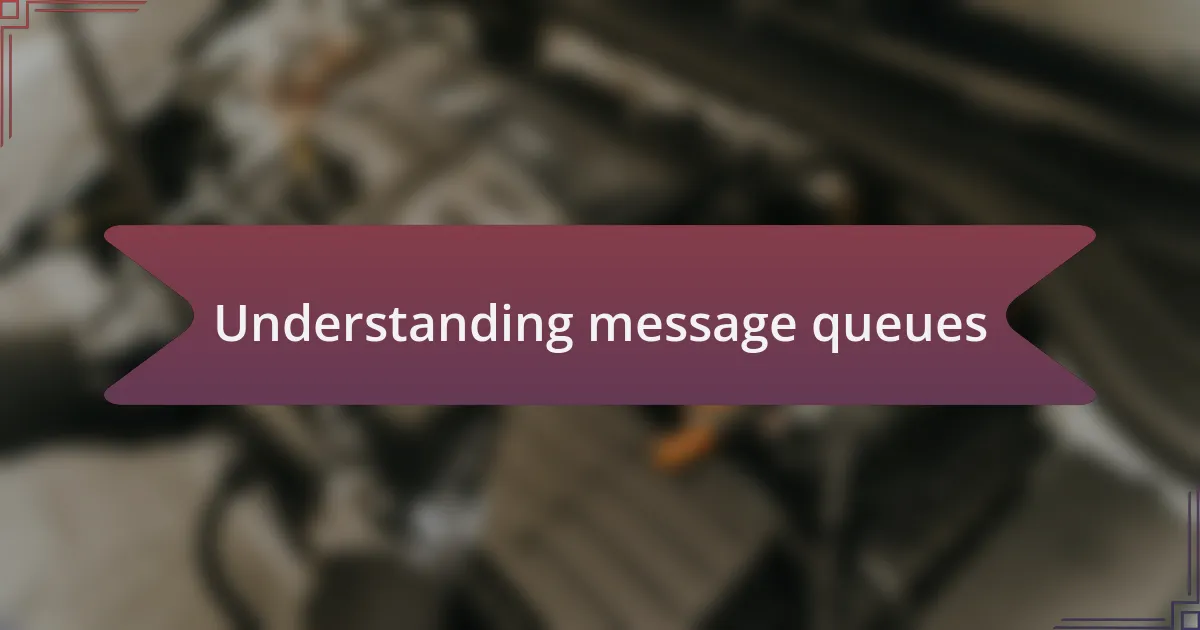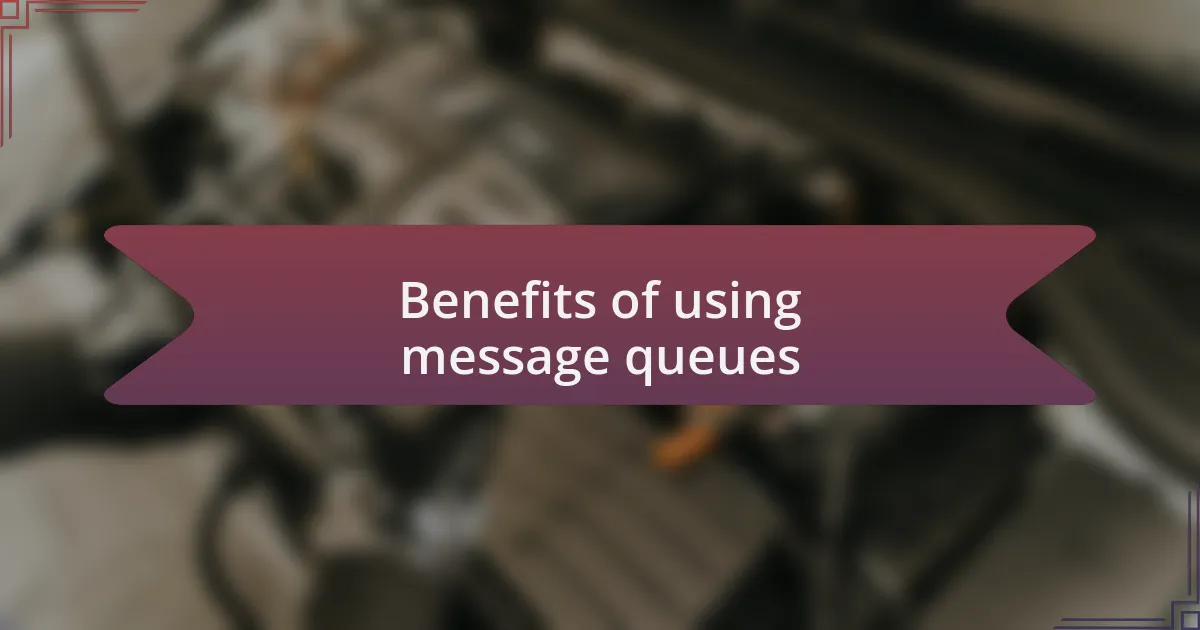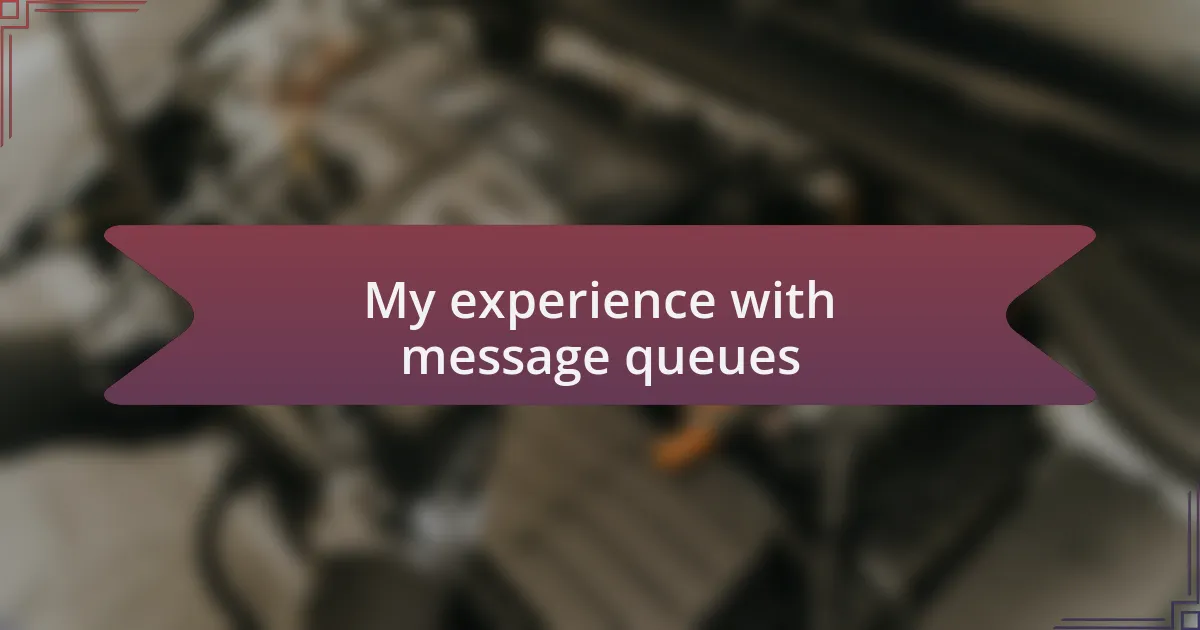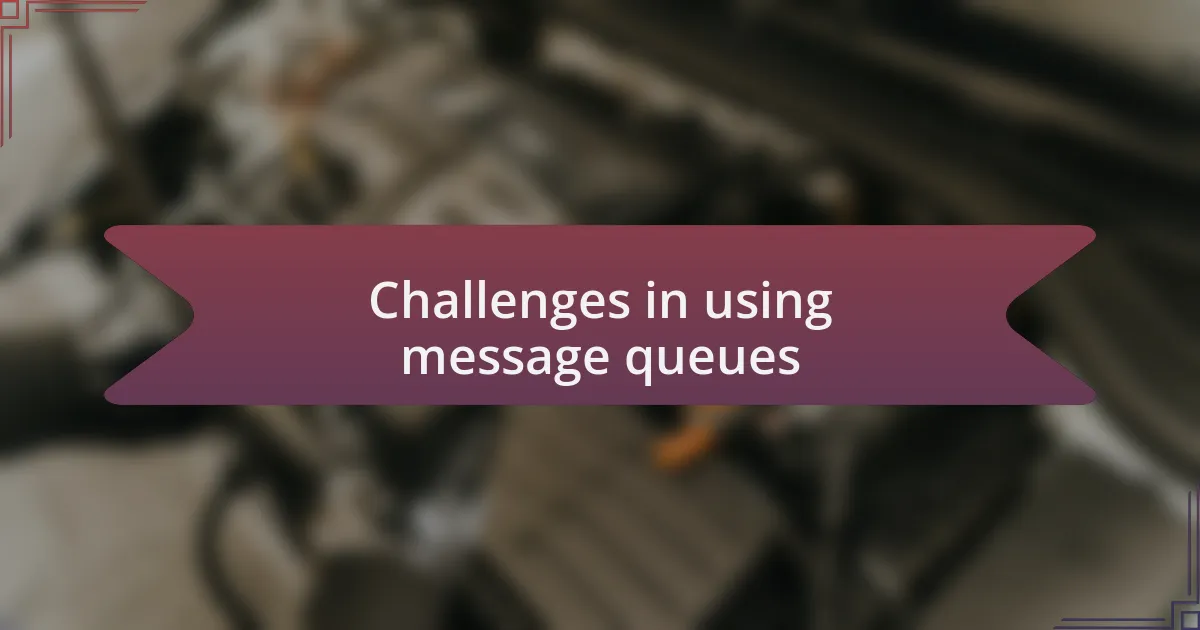Key takeaways:
- Message queues facilitate asynchronous communication, enhancing system resilience and preventing data loss during failures.
- They decouple application components, allowing independent development and improving fault tolerance across services.
- Implementing best practices like comprehensive monitoring, optimizing message size, and using dead-letter queues can significantly enhance the efficiency and reliability of message queue systems.

Understanding message queues
Message queues are essential components in modern software architectures, acting as the intermediaries for communication between different services or applications. I remember when I first encountered a message queue; it felt like discovering a secret passageway that allowed various parts of my application to converse without directly interfering with one another. Have you ever tried to coordinate a discussion among a large group of people? That chaos mirrors what happens when services attempt to communicate directly, often leading to bottlenecks or failures.
In essence, message queues facilitate asynchronous communication, enabling different parts of a system to send and process messages at their own pace. Think about the last time you sent a text message while multitasking; you didn’t have to wait for a response right away, and this flexibility allowed you to continue your day without interruption. This is precisely the kind of efficiency message queues bring to software development, allowing for smoother operations and increased scalability.
Moreover, message queues can provide a safety net in the event of failures. My experience with a project that relied heavily on a message queue was transformative; we were able to queue messages even during server downtime, ensuring that no critical data was lost. Doesn’t it feel reassuring to know that there’s a system in place to prevent data loss when unexpected issues arise? This reliability is a significant reason why many developers choose to implement message queues in their projects.

Importance of message queues
The importance of message queues in software development cannot be overstated. I’ve often found that they serve as the backbone of distributed systems, ensuring that components can function independently and still communicate effectively. When I worked on a microservices project, we opted for a message queue to handle inter-service communication, and it felt like the glue binding everything together, allowing each service to evolve without breaking the whole system.
One of the standout benefits of message queues is their ability to enhance system resilience. In a recent application I developed, we faced an unexpected surge in user traffic, which could have easily overwhelmed our services. However, thanks to our strategically implemented message queue, we managed to buffer requests without crashing—like catching a wave instead of being swept under it. Doesn’t that shift your perspective on how to handle increased loads and potential failures?
Finally, I can’t forget to mention the impact on system scalability. I remember a pivotal moment when we decided to scale our application, and the message queue played a crucial role. As we added more services, the queue allowed us to balance the load seamlessly. It’s remarkable how such a simple concept can make a complex architecture feel manageable. How could any serious project ignore such a vital element?

Benefits of using message queues
One of the primary benefits of using message queues is their capability to decouple application components. I recall a challenging project where different teams were responsible for distinct features. By implementing a message queue, we allowed those teams to work independently without hindering each other’s progress. Did it streamline our workflows? Absolutely! It felt liberating to see how tasks could flow smoothly without bottlenecks.
Moreover, message queues facilitate improved fault tolerance. In one instance, during a critical deployment, one of the services faced downtime. But, because we had a message queue in place, the other services continued processing messages without a hitch. It was reassuring to know that our system could gracefully handle failures, maintaining user satisfaction even in tough situations. Isn’t it a relief to think that even when things go wrong, there’s a safety net in place?
Another significant advantage is the ability to prioritize tasks effectively. I remember when we needed to differentiate between high and low priority messages in a real-time data processing application. With the message queue, we could implement this prioritization effortlessly. It was like having a traffic cop guiding requests through our system. Can you imagine the chaos that would ensue if we hadn’t been able to manage priorities? The peace of mind that comes with controlled request handling is invaluable.

My experience with message queues
Using message queues has significantly shaped my approach to software architecture. Early in my career, I encountered a complex system where services were tightly interlinked. It became painfully clear how fragile that setup was. Once we integrated a message queue, it felt like flipping a switch. Suddenly, the components felt free and alive, dancing to their own rhythm while still communicating harmoniously. Have you ever felt that sense of liberation when a project shifts from chaos to order? It’s remarkable.
In another experience, I worked on a team where we had to scale rapidly due to an unexpected surge in users. I vividly remember the anxiety surrounding our ability to handle increased load. That’s when we turned to message queues. They allowed us to seamlessly buffer requests, ensuring the user experience remained smooth despite the backend pressure. It was exhilarating to watch as our system managed traffic spikes with ease, making me truly appreciate the behind-the-scenes magic of message-driven architectures.
I also encountered situations where debugging became a nightmare due to asynchronous operations. Initially, I felt overwhelmed analyzing message flow. However, over time, I learned to embrace it. With the right monitoring tools in place, each message became a breadcrumb, guiding me through the labyrinth of interactions. Have you ever unraveled a tough puzzle and felt a rush of satisfaction? That’s exactly how it felt when I finally understood the entire flow. It’s this journey, fraught with learning and surprises, that has deepened my respect for message queues.

Challenges in using message queues
When using message queues, one of the biggest challenges I faced was the complexity of managing message failures. I remember an instance when a critical message got lost in transit. The panic that ensued was palpable; it felt like a weight pressing down on our team. How do you diagnose an issue that’s not directly visible? I quickly learned that implementing robust error handling and retry mechanisms is crucial, but this also adds layers of complexity to the system.
Another hurdle I encountered was ensuring message ordering. There was a time when processing messages out of order led to miscommunication between services and eventually resulted in data inconsistencies. It frustrated me to see the repercussions ripple through our application. Have you ever struggled with a system that just wouldn’t play along? To address this, I had to implement a priority system for messages, which, while effective, introduced its own set of complications. Balancing throughput and order became a delicate act.
Scalability is often touted as a primary benefit of message queues, yet my experience showed that it can also become a challenge. As our user base grew, I encountered unexpected bottlenecks. It dawned on me that simply deploying more consumers might not solve the problem. How do you ensure that your message processing architecture can scale effectively? In response, we had to invest time in analyzing throughput and optimizing consumer performance, which was a tedious but necessary process to keep things running smoothly.

Best practices for message queues
In my experience, one of the best practices for managing message queues is to incorporate comprehensive monitoring and logging. I remember the relief I felt when we implemented tools that provided real-time insights into our messaging system. Suddenly, we could visualize message flow, track failures, and debug issues more efficiently. Have you ever watched a movie with no idea of how it ends? Monitoring eliminates that uncertainty, allowing teams to react proactively rather than scrambling during a crisis.
Another important consideration is message size. Early on, I made the mistake of sending bulky messages, which led to performance hiccups that felt like taking a step back instead of forward. Streamlining the data you send can significantly enhance throughput and reduce latencies. It may feel like an extra effort at first, but trust me—it’s worth the performance gains that come from keeping your messages lean.
Finally, don’t underestimate the value of using dead-letter queues (DLQs). During one project, we set up a DLQ to track failed messages, and it changed the game for us. Instead of letting failed messages disappear into the void, we could analyze them later to understand why they failed. This practice not only improved our system’s reliability but also gave our team invaluable insights into potential design flaws. Why wouldn’t you want that level of clarity?